Will Amateurs Be Able to See the New Interstellar Comet? – Sky & Telescope
We’re all crossing our fingers we’ll see the new comet in our telescopes. Here are some tips on making the best of this rare apparition.
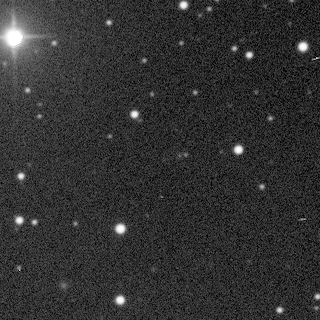
Comet Borisov (C/2019 Q4) — at center — slowly slides across the sky in this time-lapse made with a 17-inch telescope on September 12, 2019.
José Chambó
I planned to write about something entirely different this week, but interstellar comets have a way of shifting priorities. Comet Borisov (C/2019 Q4), the second interstellar minor body to enter the solar system, is now feeling the pull of the Sun and speeding toward a December 7th perihelion. It arrived from points unknown traveling at 33 km/s and will reach a peak velocity around 44 km/s at perihelion.
As Comet Borisov approaches both the Sun and the Earth, its brightness is expected to increase from the current magnitude of 17 to about 15 when closest to the Earth on December 28th UT.
Astronomers obtained spectra of the object using the 4.2-meter William Herschel Telescope on La Palma in the Canary Islands and the 8.2-meter Gemini North telescope on Maunakea in Hawai‘i. The comet’s slightly reddish surface color resembles that of our own solar system’s long-period comets, two recent examples of which are comets Hale-Bopp (1997) and Hyakutake (1996).
Almost immediately after the announcement of Comet Borisov’s discovery, amateurs got to work imaging the faint object. Although it isn’t any more than a blip at present, some of us are hopeful we’ll spot the comet visually closer to the time of perihelion.
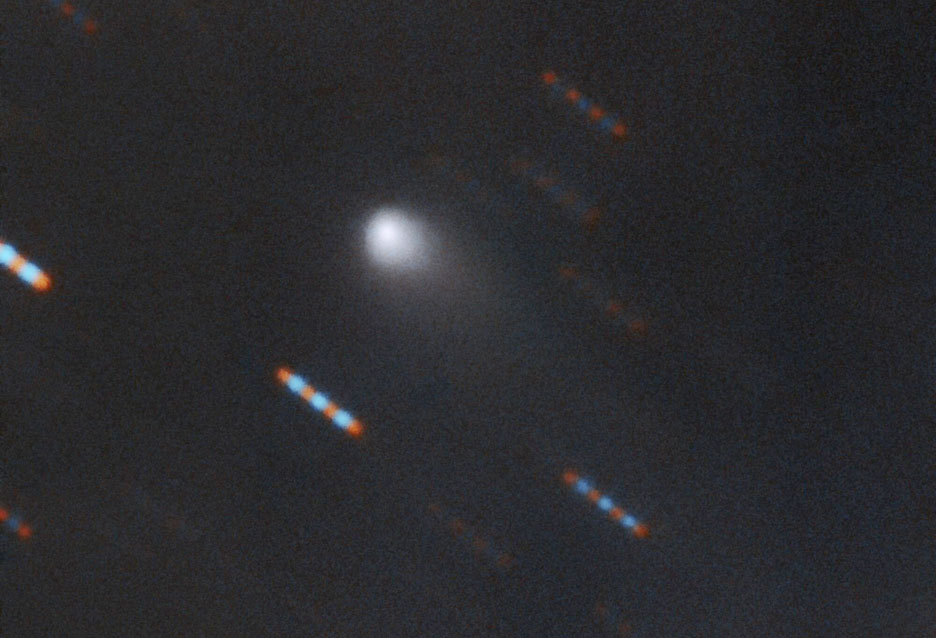
Comet Borisov looks a little like a cosmic shuttlecock with small, bright head and faint, extended tail on September 9, 2019. The photo is a composite of four 60-second exposures through red and green filters with the Gemini North Telescope’s spectrograph on Hawai‘i’s Maunakea. Blue and red dashes are stars that trailed during the time exposure while the telescope tracked the comet. The comet is expected to receive the designation 2I/Borisov very soon.
Gemini Observatory / NSF / AURA
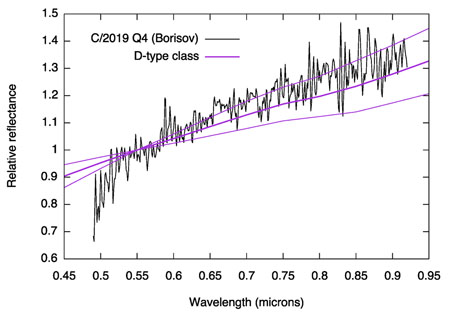
The spectrum of Comet Borisov (jagged curve) tracks well with D-class minor bodies, like many outer main belt asteroids and long-period comets. D-type asteroids are reddish and may be enriched in organics and possibly water ice.
Julia de León et. all / Roque de los Muchachos Observatory, La Palma
Hope and optimism can be almost as important as aperture when it comes to seeking out faint targets visually. Let’s look at the predicted magnitude peak of 15.0 given in the most recent International Astronomical Union (IAU) electronic telegram issued on September 18th. Based on observing many comets over decades, we probably can rule out seeing the object in anything smaller than an 8-inch telescope under pristine skies. The limiting stellar magnitude for an 8-inch under excellent conditions is about magnitude 14.7. Because Comet Borisov is an extended object it will appear even fainter and likely out of viewing range. Naturally, I hope someone proves me wrong!
How to View Comet Borisov
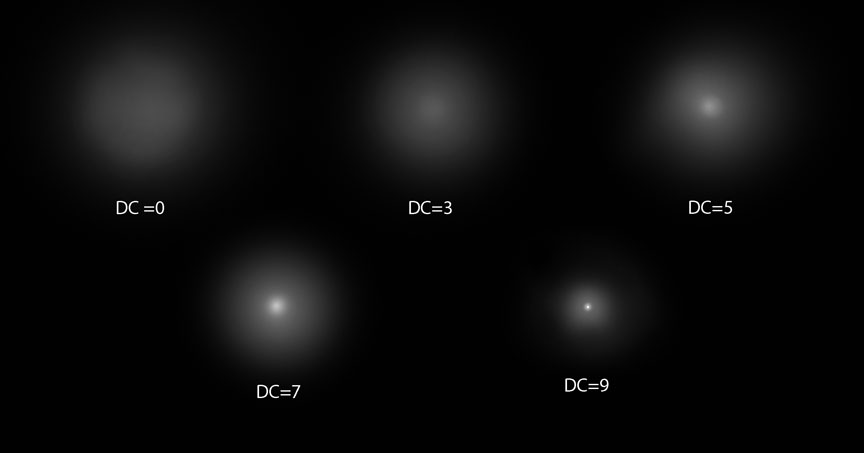
Diagram showing degrees of condensation of a comet’s coma from 0 (none) to 9 (nearly stellar).
Bob King
Moving to a 10-inch instrument under similar viewing conditions, the limiting magnitude drops to 15.1, allowing for the tantalizing possibility of actually seeing the object. As comet observers know well, visibility depends on the coma’s degree of condensation, or “DC.” DC ranges from 0 for a completely diffuse object with no condensation at its center to 9, a comet so compact it appears stellar.
Size matters, too. Large, extended objects are generally more difficult to discern than small, compact ones. An 8th-magnitude comet can appear extremely faint if it’s large and has a low DC because its light is spread across a large area. Likewise, a 9th-magnitude comet with a DC of 1 is trickier to see compared to another 9th-magnitude comet with a DC of 8.
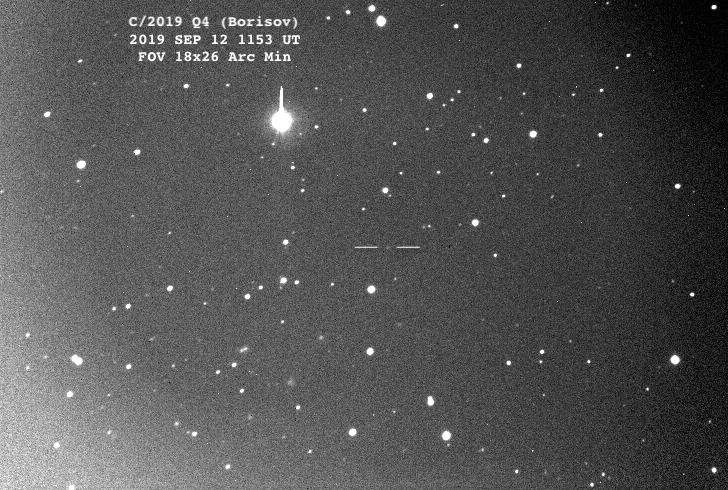
Comet Borisov, photographed on September 12, 2019, by amateur astronomer Patrick Wiggins. He writes: “Not much to look at but considering the wild fire smoke in the sky, the sky glow from a nearly full Moon, and the time I took it being so close to sunrise I’m frankly surprised I got anything at all.” We’re happy you did!
Patrick Wiggins
Right now, Comet Borisov is small and compact with a short tail pointing northwest. If the comet remains compact or nearly stellar and reaches magnitude 15.0, experienced observers might spot it in a 10-inch. Chances improve for telescopes 12-inches (30.5-cm) or larger under dark, moonless skies. Equally important is to use high magnification to “expand” the small object and further darken the sky background. I recommend 200× or better.
You can keep track of what others are seeing and judge whether the comet is in your viewing range by subscribing to the Comets Mailing List, a clearinghouse for amateur comet observations. I’ve been tipped off to many discoveries, outbursts, and late-breaking developments thanks to the zeal of its members.
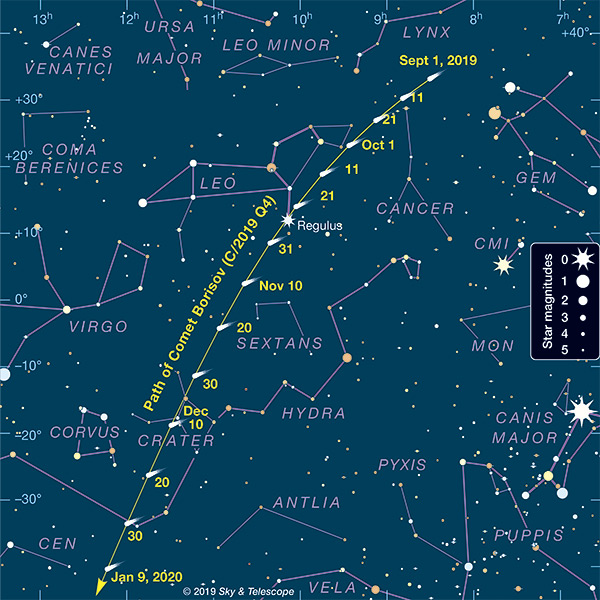
This map shows the comet’s position through January 9, 2020, at 0h UT for the dates shown. Click the image or download a larger black-and-white PDF here. As December approaches, we’ll provide a more detailed map so you can hunt for it with your scope.
Sky & Telescope
My own personal limit with a 15-inch (38-cm) scope is about magnitude 14.5 for small, compact comets, placing Borisov’s comet at the edge of visibility. If faintness isn’t enough, weather and altitude also come into play. When brightest in December, clouds are often a problem (at least across the U.S.) and cold temperatures can give some observers second thoughts about heading outside at 5 in the morning. Yes, that’s the time the comet stands highest in the southern sky before dawn, so stock up on hand warmers now.
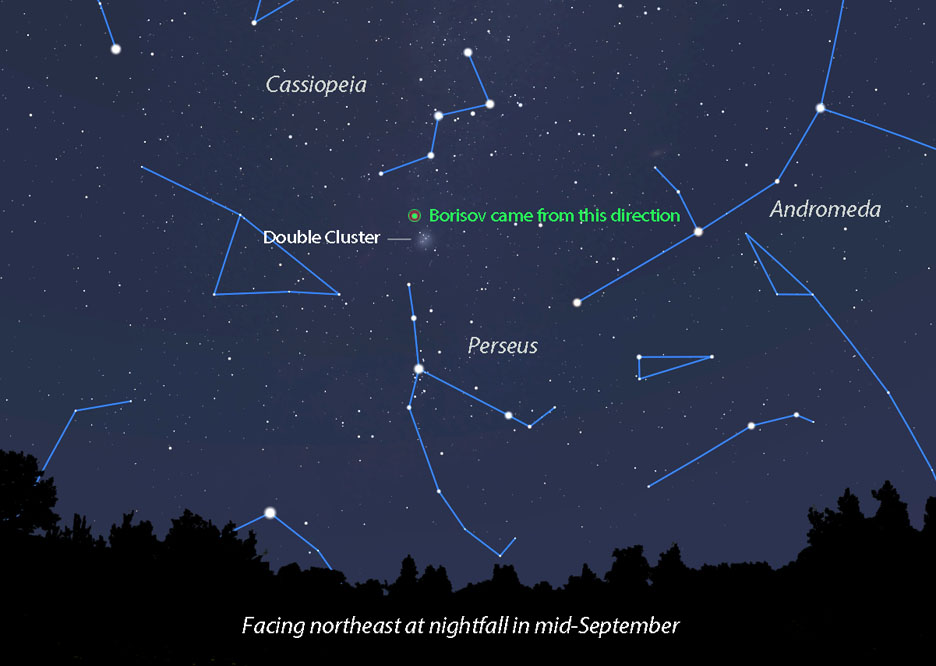
Comet Borisov hails from a distant point in Cassiopeia, not far from the direction of the Double Cluster in neighboring Perseus.
Stellarium
Plan for December
From early December through early January 2020, when Comet Borisov is expected to be brightest, it will travel about 0.8° per day from central Crater (declination –19° on December 11 UT) south to Centaurus (declination –40° on January 9 UT). Suffice to say that northern visual observers should plan to look for the object in early December before the waxing moon enters the morning sky around December 11. Moon-free skies return again around December 22. Observers in the southern U.S. and farther south will have the best and most extended viewing opportunities.
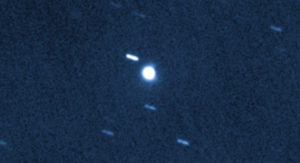
Comet 29P/Schwassmann-Wachmann is normally a 14th magnitude diffuse glow, but when it undergoes an outburst, shown here on Sept. 23, 2018, it transforms into a bright, strongly condensed object.
Jean Francois Soulier
Comets can also surprise. While it’s possible Comet Borisov will obey predictions, it’s not obligated to do so. When near the Sun, comets become active, releasing massive amounts of vaporized ice and dust through geyser-like jets. Sometimes fresh fissures or a fragment breaking off the comet exposes additional fresh ice. As the material rapidly vaporizes in sunlight the comet’s brightness can temporarily skyrocket overnight by a magnitude or more.
Or they can crumble and fade the way Comet Elenin (C/2010 X1) did when it disintegrated shortly before perihelion. This is unlikely to happen with Comet Borisov because it will pass relatively far from the Sun, at a distance of 2 a.u., at perihelion.
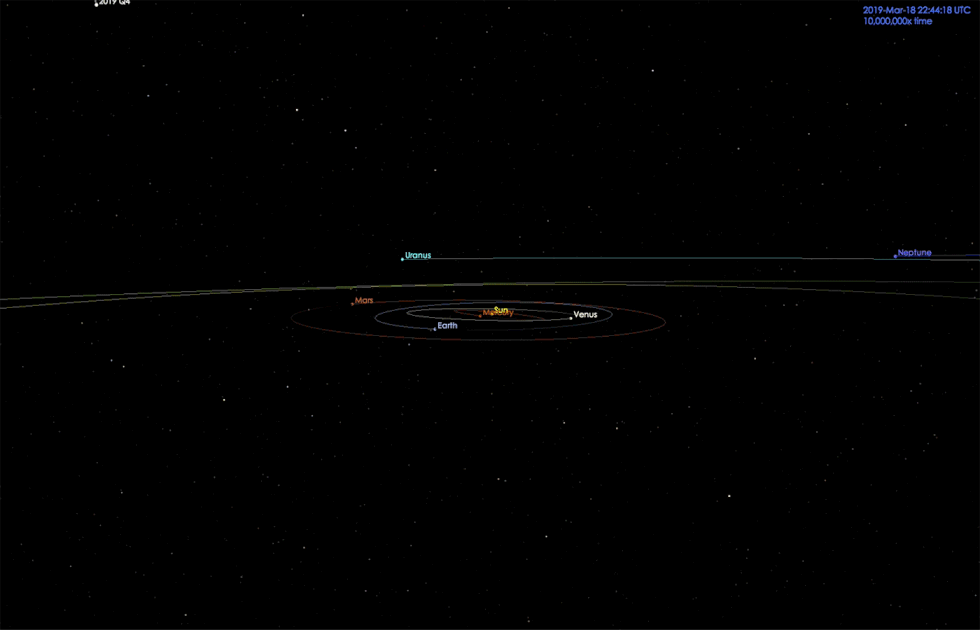
This animation shows the comet’s dramatic plunge through the plane of the solar system starting in March 2019 (top) through February 2020.
Instituto de Astrofísica de Canarias – IAC
A word about magnitudes: Published magnitudes on the JPL Horizons site and available through IAU Circulars tend to be conservative. My own experience, as well as that of Alan Hale, co-discoverer of Comet Hale-Bopp, has shown that real-time magnitudes are often a little brighter. Not always, and not that this is guaranteed to happen to Comet Borisov, but take the numbers with a grain of interstellar dust.
Where Are All the Interstellar Comets?
You’ll be interested to know that the subject of interstellar comets was investigated by Asoke K. Sen and N. C. Rana in a paper titled On the Missing Interstellar Comets summarized in the January 1994 issue of Sky & Telescope. Sen examined the frequency of interstellar comets passing through our solar system at a time when many astronomers had given up hope of ever finding them. It was assumed that stars in the solar neighborhood possessed their own Oort Clouds. Stellar encounters over time should have stripped away enough comets for astronomers to have detected as many as six interstellar visitors in the past 150 years. Yet not a single one had been found.
Sen argued that stars in binary or multiple systems can’t have Oort Clouds, leaving only single star systems as comet contributors. Based on this smaller subset of candidates, he revised the frequency to one comet every 200 years — a nice fit with current observations!






